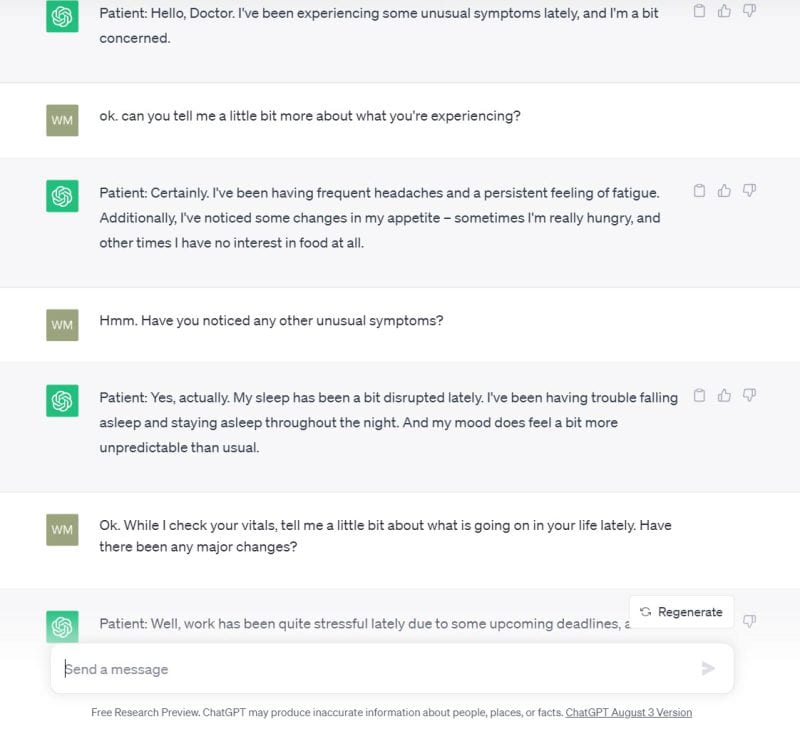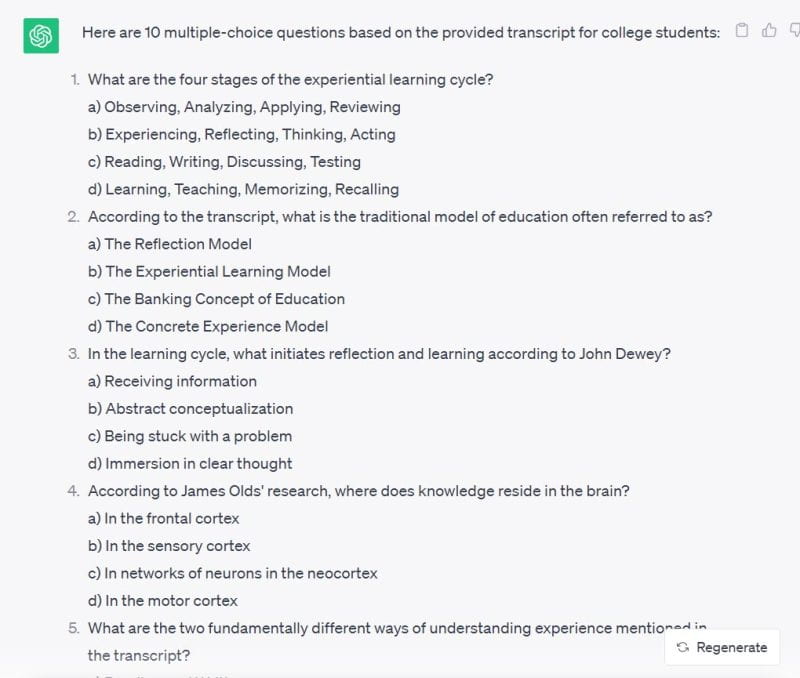Harnessing generative AI tools for Assignments, Activities, and Assessments

by Walter Milner, Instructional Designer IV, Learning and Educational Center
Now that generative AI (gAI) has become available to the wider public, there has been a lot of discussion about the implications of these tools on the world of higher education. One of the interesting areas for exploration is the ability to leverage the use gAI for coursework such as assignments, activities, and assessments. How can gAI be used as both a student tool for learning and a faculty tool for designing learning? Ideas are continually emerging, and the possibilities seem endless. Here are a few examples.
Student Tool for Learning
Students may benefit from coursework that utilizes generative AI in different ways. One way is through role-plays and simulations.
 Health science students, for example, can be directed to prompt a tool such as ChatGPT to take on one side in a role play activity where the student is a doctor and ChatGPT is the patient. Students can be directed to specify symptoms and have a minimum number of interactions. Students can also be directed to have a debate with ChatGPT or a dialogue about a concept, with instructions that direct them to include a specific number of facts or exchanges. Students studying poetry forms can be directed to prompt ChatGPT to put a historical event or other topic into a specific poetry form to help them understand how form contributes to expression of meaning (Alexander, 2023). A business student can prompt for a critique of their marketing strategy, and a psychology student can ask a gAI tool to persuade them to join a cult or political organization and then analyze the persuasion techniques that were used in the response.
Health science students, for example, can be directed to prompt a tool such as ChatGPT to take on one side in a role play activity where the student is a doctor and ChatGPT is the patient. Students can be directed to specify symptoms and have a minimum number of interactions. Students can also be directed to have a debate with ChatGPT or a dialogue about a concept, with instructions that direct them to include a specific number of facts or exchanges. Students studying poetry forms can be directed to prompt ChatGPT to put a historical event or other topic into a specific poetry form to help them understand how form contributes to expression of meaning (Alexander, 2023). A business student can prompt for a critique of their marketing strategy, and a psychology student can ask a gAI tool to persuade them to join a cult or political organization and then analyze the persuasion techniques that were used in the response.
Students can also be directed to create visual representations (with tools such as Bing’s Image Creator, for example) of concepts they are learning in order to analyze, connect with, and reflect upon those concepts (Alexander, 2023).
Similarly, a science or ancient history course could have an activity where students create visual representations of things that cannot, or have yet to be, seen, so that they can imagine what it would look like, or analyze the generated image for accuracy according to the content they are learning. A more general way that gAI can help students learn is through tutoring. Artificial Intelligence provides opportunities for adaptive and personalized interactions that can help students to practice skills and learn content (Zawacki-Richter et al., 2019).
Generative AI is not an end unto itself, but rather a means to support learning. The main focus is the learning goal itself, and then gAI can be considered as an additional tool to support learning that content (Alexander, 2023). Regardless of the chosen activity, these tools will be most useful if they are accompanied by reflection and discussion. Students can be guided to know that outside knowledge and sources are integral to analyzing the results given by generative AI. One way to accomplish this is to have students verify their results with other sources. Course activities that utilize these tools will be more effective with required reflections and analysis of the results, and students can be directed to share direct results from the tool they used. ChatGPT, for example, allows users to share the link to their results. With image generators, students can share the image along with their prompts. Faculty can also guide students through discussions that analyze whether gAI tools are useful for areas such as research and learning, as well as through analysis of potential problems with the results.
Faculty Tool for Design of Learning
Faculty may find generative AI tools useful in a number of ways while preparing for courses and designing coursework. One of the most basic ways is to save time when it comes to brainstorming or outlining ideas. An instructor can prompt for an outline to a course, or a set of learning objectives, for example. Specifics such as number of weeks, content to be covered, or the use of Bloom’s taxonomy can be included in the prompt. Faculty can also create rough drafts or outlines of lecture notes. It is useful to recognize that the results would only be a starting point to then be modified and adapted, or to simply give the instructor ideas for their own work.
Generative AI can also be used to create quiz questions. Questions can be created from lecture notes or video transcripts, for example.
These tools can also be leveraged to create larger numbers of questions for quiz banks. Faculty should be sure to review and doublecheck the questions and answers for accuracy. Generative AI may also be useful to create case studies, scenario-based examples, and varied explanations of concepts which may all be helpful to students when it comes to learning the content covered in a class. These are strategies which have demonstrated value in learning but are time-consuming and challenging for instructors to develop (Mollick & Mollick, 2023).
Yet another idea would be to use gAI for creative endeavors, such as providing a rough draft for a podcast episode on a topic. Faculty may also want to experiment with analyzing student responses to assess gaps in learning or concepts that need reinforcement, however if this is done it should be noted that no identifiable student data or personal information should be included in the prompting in compliance with FERPA laws protecting student privacy.
Concerns over Equity and Accessibility
As these tools make their way into courses and course design, it is imperative that significant thought be dedicated to whether these tools are accessible and available to all students. Many of these questions are still lingering and unsolved. In some ways, gAI can be leveraged to make material more accessible, such as language translation, or summarizing information in ways that are accessible to someone with a particular learning challenge. Yet, it is not clear if all of these tools are accessible to someone who relies on a screen reader, for example. When utilizing these tools for student work, consider accessibility implications and if there are challenges, provide alternatives to students. Faculty should also consider whether the tools students are being directed to use are free or limited in free versions and be aware that some students may pay on their own for more robust versions of these tools. Faculty may want to consider directing students to only use free tools, so they are not burdened with additional costs.
Bibliography
Alexander, B. (2023, June 9). Teaching creatively with AI [Video]. www.youtube.com.
https://youtu.be/vrxNpMnVeFc?si=orGBRpneotlcD4kU
Mills, A. (2023). AI text generators: Sources to stimulate discussion among teachers. Google Docs.
https://docs.google.com/document/d/1V1drRG1XlWTBrEwgGqd-cCySUB12JrcoamB5i16-
Ezw/edit#heading=h.omg0criub54r
Mollick, E. R., & Mollick, L. (2023). Using AI to implement effective teaching strategies in classrooms: Five
strategies, including prompts. SSRN Electronic Journal. https://doi.org/10.2139/ssrn.4391243
Stanford, D. (2023, July 12). Incorporating AI in teaching: Practical examples for busy instructors. Daniel
Stanford’s Substack. https://danielstanford.substack.com/p/incorporating-ai-in-teaching-practical?sd=pf
Zawacki-Richter, O., Marín, V. I., Bond, M., & Gouverneur, F. (2019). Systematic review of research on
artificial intelligence applications in higher education – where are the educators? International
Journal of Educational Technology in Higher Education, 16(1). Springeropen.
https://doi.org/10.1186/s41239-019-0171-0

